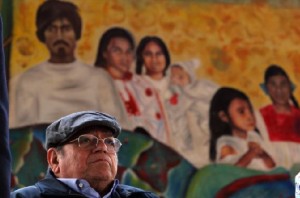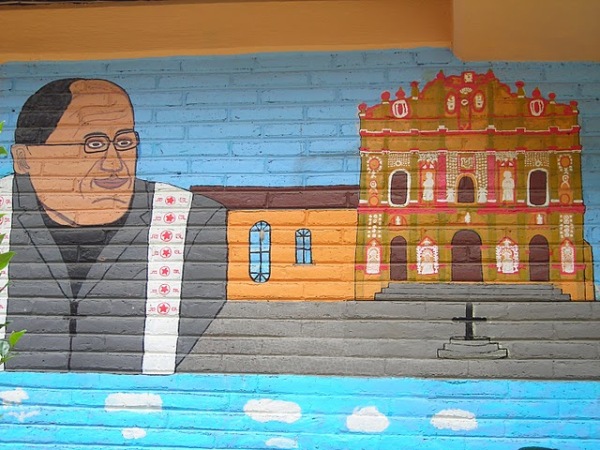Tata Sam…
John Donaghy, Hermano Juancito, quotes from an 2000 interview with a Des Moines Cathoic publication from Samuel Ruiz Garcia, who passed away earlier this week at the age of 86.
It’s a very well known saying that if someone offers you a fish, you don’t take it. You ask him to teach you how to fish.
So, Pedro learns how to fish. He goes to the store and he says, “I want to buy a net and I want to buy a hook,” And the owner of the store says, “Uh, what’s going on here, Pedro? You learned how to fish?”
He says, “Yeah, I learned how to fish.” Then the owner says to him, “OK, but what you didn’t know is you have to sell me a portion of your fish.” And Pedro says, “OK,” and he goes out and starts fishing.
He’s on the edge of the lake and soon he feels somebody tapping on his shoulder and somebody is standing there, telling him, “What’s going on here? You can’t be fishing here. This is private land.” And so they push him off.
Pedro has been given a skill, but that’s not enough. You can work on the “development” of the individual person, but the other half of that is working on the structural injustices.
In his forty years as Bishop of San Crisobal de Chiapas, and his tireless pursuit of justice since his retirement in 2000 (at age 75), Sam Ruiz spent far more than half of himself working to undo the structural injustices.
While relatively young when named Bishop (only 35), the Bajio native was hardly a naïf, the product of a solid Jesuit education, and graduate study at the Gregorian Institute in Rome, a sort of training school for future Bishops.
Still, when Ruiz was sent to Chiapas in 1959, he was unprepared. Although Mexico in the late 1950s had endemic poverty everywhere, the fruits of the 1910-20 Revolution had created a modern, seemingly progressive culture. Chiapas, then a little visited backwater, and still seen as something of an accidental appendage to Mexico (it was, after all, part of the Guatemala under the Viceroys), had been by-passed by the Revolution. As Carlos Marín wrote (Proceso, 1105, 4 January 1998):
… due to geographic isolation, social introversion, lack of political capability of the subsequent presidencies, Central American influence, and its great ethnic diversity, the Chiapans suffered from “national indifference” so they participated with little interest, or symbolically, in the historical development of present day Mexico. This “national indifference” or lack of national will, made it so that while the other federative entities developed themselves historically by means of their active and dynamic participation, like fusing their customs, political ideologies, economic and social procedures, and psychological situations, the Chiapans participated in nothing or in very little, for example, in the War of Independence, the battle between Centrists and Federalists, North American interventions, the War for Reform, French intervention, and the Mexican Revolution.
Perhaps, if I ever revise Gods, Gachupines and Gringos, I will need to add “except in Chiapas” to some of my more generic statements. Like this one: At the end of the Second Word War México was still poor and agriarian, but more prosperous than it had ever been. The Revolution had eliminated the worst abuses of Porfirismo: hacienda and peonage were horror stories told by aging relatives…”
Peonage may have gone, but — as in the much of the United States at the time— in Chiapas the forms of expressing racial and social inequality were unchallenged. Indigenous people were not permitted to use the sidewalks s in San Crisobal and — as the new Bishop began to visit his diocese (often by mule: then, as now, often the only reliable means of transit to remote communities), he uncovered even more startling evidence that the old order had not passed away — indigenous workers were still being whipped, and local landlords still practiced “droit de segnor”, the right to “test” the virginity of prospective brides among his dependent workers’ families.
Bishops of Chiapas have always preached against Heresy. The indigenous peoples pre-Conquest beliefs and practices might also be considered heretical. European pre-Christian beliefs and practices, having been washed of any hint of heresy by the 17th century Council of Trent, it was safer for Bishops of Chiapas to stick to futile sermons — in Spanish, the language of the conquers, not the conquered — against folk beliefs, and shamanistic practices, than to challenge the sins of the economic and political power elites.
On the other hand, the elites have their own unorthodox practices. Thomas Gage, in the early 17th century, wrote of heretical trend among the Chiapan upper crust (albeit, a more harmless one — sipping hot chocolate during Mass) that ended with the Bishop’s assassination by a chocolate sipping cabal. But, Bishop Samuel’s See is named for its founding Bishop, Bartolomé de las Casas, who well into his 90s was crossing the Atlantic in small sailing ships to bring abuses against the indigenous Americans to the authory’s attention… and who, as an officer of the Inquisition, had slave-holders burned at the stake for their heretic ideas on human inequality.
Bishop Sam chose to hark back to the Dominican Las Casas. He dedicated himself to his indigenous congregants, learning their languages, building trust in their communities and — as it is said a good churchman should — “comforting the afflicted and afflicting the comfortable.” With the Second Vatican Council of the early 1960s. Laura Carlsen writes
Don Samuel Ruiz formed part of and led a movement within the Roman Catholic Church that based its theology on the Vatican II commitment to greater lay participation, the “option for the poor” that shifted attention to the need to serve the historically downtrodden, and the idea that the church cannot ignore injustice without being complicit.
These would become the principles he acted on. As mediator in the Zapatista indigenous uprising of 1994, Ruiz helped create the conditions for the new indigenous movement that marked not only Mexico but the world. His work as leader of the National Mediation Commission (CONAI) led to an unprecedented dialogue that resulted in the San Andrés Accords on Indigenous Rights and Culture, signed and later violated by the federal government. The Accords stand as a tribute to his work and the work of scores of indigenous leaders. They also stand as a tragic reminder that the word of the powerful cannot be trusted. But the spirit of emancipation and peaceful dialogue codified in the Accords survives in the individuals gathered at the mass for Don Samuel Ruiz, one of the principal architects of the peace process, and among the thousands of indigenous people who wait to receive his remains in his beloved state of Chiapas.
Don Samuel insisted that the church of the poor needed a human rights organization in Chiapas faced with the extreme human rights violations taking place. In 1989, he founded the Fray Bartolome de las Casas Center for Human Rights. The Center’s mission is to “walk alongside and at the service of the poor, excluded and organized people who seek to overcome their socioeconomic and political situation, by taking direction and the strength from them to contribute to their project of building a new society where people and communities fully exercise and enjoy their rights.” The mission embodies the strong belief that the church cannot be separated from the struggle for social justice and that it should play a supporting role rather than pronouncing from on high.
His work as a churchman and human rights mediator earned him honor after honor throughout
Latin America… and the hatred of many. Of course, in Mexico, a cleric cannot overtly take a political stance, but after constitutional changes in 1992, Bishops have been able to make their political views clear. Elsewhere in Mexico, the higher clergy have made their preference known for more conservative, anti-revolutionary movements, while Bishop Sam, having sided with the indigenous congregants, openly supported the Zapatista movement (where he was sometimes, half-jokingly referred to as “Subcomandante Obispo”) and the PRD. While the elites, in their rage against him, with odd (and sinister) groups like the Lyndon Larouche backed “IberoAmerican Solidarity Movement” making death threats against him, Don Samuel more than anyone else, became the visible symbol of Chiapas.
I’m still amazed that so many, especially Europeans think of Chiapas as the “real Mexico”. That is perhaps, yet another of Don Samuel’s legacies: Chiapas — the accidental Mexican backwater — became, to use theological terms, “an outward and visible sign” of Mexico’s on-going struggle to create a national consensus within a multi-cultural, multi-ethnic society and justice in an unjust world. The Church, let us remember, has been in the international public relations game a lot longer than the Zapatistas. Without the energy and resources of Bishop Sam behind them, the movement might have been written off as just another Latin American guerrilla movement, and quashed without much notice outside the region.
The Chiapas “situation” — and the meaning of it — has been uncomfortable for Mexico, and for Latin America in general. And for the Church. Bishop Sam, as a “liberation theologian” put him at odds with the Mexican hierarchy, and with the Vatican. As with other liberationists, the moral “preference for the poor” led to political preferences not favored by the elites here, or in Washington. As he said in an AFP interview in 2005 “Theology interests us less than liberation.” A man to be feared, and — if possible — marginalized much as Chiapas has been.
Forced out — ironically because his tolerance for local practices could be used to insist upon his retirement, his successor, Raul Vera, has carried Don Samuel’s legacy to the north, while Chiapas’ present Bishop, the very conservative Felipe Arizmendi, has had to uncomfortably accommodate himself to the new order of things in Chiapas.
Marginalized by the elites. Hermann Bellinghauen writes of the memorial services held in Bishop Sam’s former cathedral:
The indigenous people are coming from the far corners of Chiapas to pay their homage to Samuel Ruiz García, jTatik (father, in Tzeltal), converging by the thousands today in the cathedral dedicated to the Catholic saint of travelers, San Cristobal.
… Since early this morning, the faithful have arrived from Simojovel, Chenalho, Chilo, Ocosingo, Tila, Las Margaritas, Motozintla: the most obscure corners of what the Zapatistas called in 1994, the “forgotten corner of the country”.
Hourly masses, with High Masses at noon and dusk, are filled with representatives from political and social organizations, church groups, and the communities communities — Tzeltal, Tzotzil, Chol, Mam, Tojolabal…
Hermano Juancito, wrote “Monday morning, January 24, a saint in our midst went to his heavenly reward.” A saint, I don’t know. Mexico has produced it’s share of them. Samuel Ruiz Garcia who had many titles — Obsipo Ruiz… Su excelencia Don Samuel Ruiz Garcia… “Subcomandante Obispo”… Don Samuel — has earned a very rare title indeed. Only a few in our history, the 16th century priest and social reformer, Vasco de Quiroga and the 1930s President, Lazaro Cardenas, are elevated by the people themselves to the status of “Tata” … or, in Tzeltal, “jTatik” — “Our Father”…










“Raul Vera”.
Thanks, Steve… hard to proofread myself, especially at 2 AM.
Interesting piece, although I must also mention another state which has been forgotten by Mexico for most of it’s history and that never really participated in the countries upheavals, Baja California Sur.